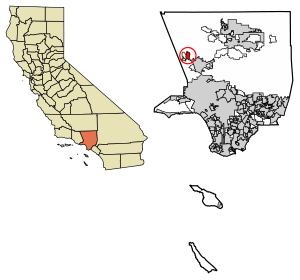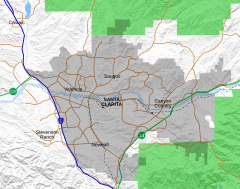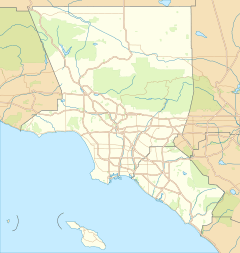Castaic, California facts for kids
Quick facts for kids
Castaic, California
|
|
|---|---|

Castaic Dam and its lake, 2007
|
|

Location in Los Angeles County, California
|
|
| Country | |
| State | |
| County | |
| Area | |
| • Total | 7.28 sq mi (18.85 km2) |
| • Land | 7.26 sq mi (18.81 km2) |
| • Water | 0.02 sq mi (0.04 km2) 0.24% |
| Elevation | 1,280 ft (390 m) |
| Population
(2020)
|
|
| • Total | 18,937 |
| • Density | 2,607.68/sq mi (1,006.87/km2) |
| Time zone | UTC-8 (Pacific (PST)) |
| • Summer (DST) | UTC-7 (PDT) |
| ZIP Codes |
91310, 91384
|
| Area code(s) | 661 |
| FIPS code | 06-11796 |
| GNIS feature ID | 2582966 |
Castaic is a community in the northwestern part of Los Angeles County, California, United States. It is an area that is not officially a city. In 2010, about 19,015 people lived there. The U.S. Census Bureau calls Castaic a "census-designated place" for counting people.
Many drivers pass through Castaic every day. They use Interstate 5 to travel to or from Los Angeles. Castaic Lake is an important part of the California Water Project. It also has a power plant that uses water to make electricity. Castaic is about 38 miles (61 km) northwest of Los Angeles Union Station. It is also northwest of the city of Santa Clarita.
Contents
About the Name
The name Castaic comes from the Chumash word Kaštiq. This word means "the eye". Later, Spanish and Mexican people spelled the name as Castéc. The name "Castec" first appeared on old maps of Rancho San Francisco. It referred to a canyon that led to an old Chumash camp. This camp was near Castac Lake, which sometimes has salty water. Early English writings used the spelling Casteque before "Castaic" became the standard way to spell it.
History of Castaic
The Córdova family of California were the first settlers in the Castaic area. Modern Castaic started in 1887. This was when the Southern Pacific railroad built a stop there. It was on the train line between Piru and Saugus Station. They named this stop "Castaic Junction". Between January and April 1890, the local school district, the Castec School District, changed its spelling to "Castaic".
The Castaic Range War
A big conflict happened in Castaic between 1890 and 1916. It was called the Castaic Range War. This conflict was about ranch borders and where cattle could graze. It was one of the largest land disputes in U.S. history.
The trouble started over a piece of land called Section 23. William Chormicle had bought this land. But William "Wirt" Jenkins was already using it to store grain. This led to a big argument. The conflict grew and involved many people. It was a long-lasting dispute that eventually ended in 1916.
Cattle Ranching in Castaic
Castaic is one of the last places in Los Angeles County that still does traditional cattle roundups. This means using horses, lariats (ropes), and branding irons. The Cordova family has done this since 1834. That is when they first settled in the area.
Members of the Cordova family helped the U.S. Army during the Mexican–American War in 1846. They also helped identify people after the St. Francis Dam disaster in 1928. In 1967, the government took about 1,000 acres (400 ha) of land from the family. This land included their old ranch house. It was needed for the planned Castaic Lake and dam.
Castaic Geography
Earthquakes in the Area
The Castaic area often has earthquakes. For example, on January 3, 2015, two earthquakes happened north of Castaic. One was a magnitude 3.1 earthquake. The other was a magnitude 4.2 earthquake. Their centers were about 14 kilometers (8.7 mi) north of Castaic. They were also about 16 miles (26 km) from Santa Clarita, California.
Castaic Climate
Castaic has hot and dry summers. Its winters are cool and have some rain. From June to September, the average high temperature is often above 90°F (32°C). Sometimes it can even go above 100°F (38°C). Castaic has a "hot-summer Mediterranean climate". This type of climate is common in areas with warm, dry summers and mild, wet winters.
People of Castaic
| Historical population | |||
|---|---|---|---|
| Census | Pop. | %± | |
| 2020 | 18,937 | — | |
| U.S. Decennial Census 1850–1870 1880-1890 1900 1910 1920 1930 1940 1950 1960 1970 1980 1990 2000 2010 |
|||
The 2010 United States census showed that Castaic had 19,015 people. Most of the people, about 99.6%, lived in homes. Only a small number lived in group housing.
In 2010, the average household income in Castaic was about $106,538. About 7.0% of the people lived below the poverty line. The population included many young people. About 30.3% were under 18 years old. The average age was 35.6 years. For every 100 females, there were about 101 males.
Most homes in Castaic were owned by the people living in them. About 84.2% of homes were owner-occupied. The rest, about 15.8%, were rented.
Education in Castaic
Younger students in elementary and middle school go to schools in the Castaic Union School District. High school students attend Castaic High School. This school is part of the William S. Hart Union High School District. Castaic High School first opened its doors in 2019.
Notable People
- Stacey Koon, policeman
- Troy Neiman, baseball player
Images for kids
See also
 In Spanish: Castaic para niños
In Spanish: Castaic para niños





